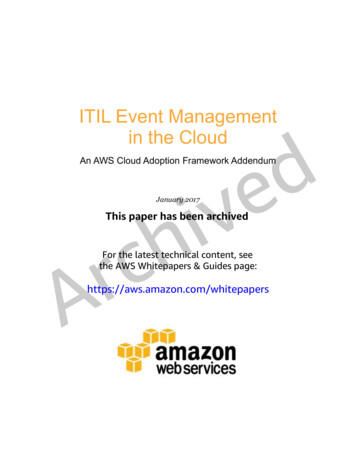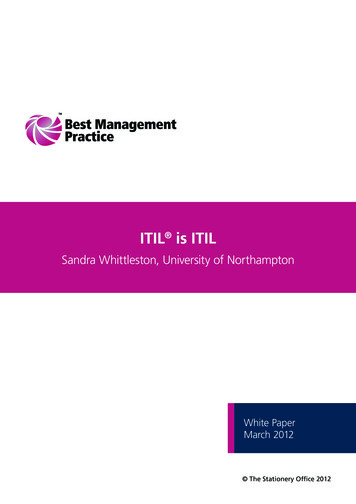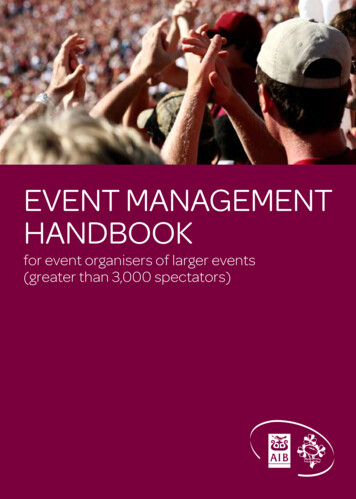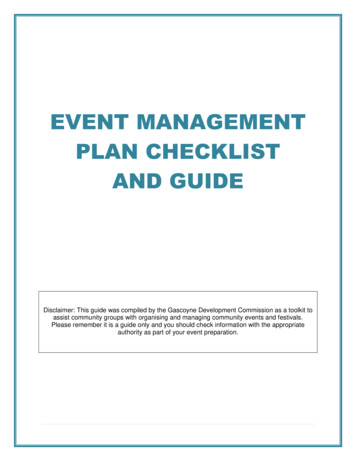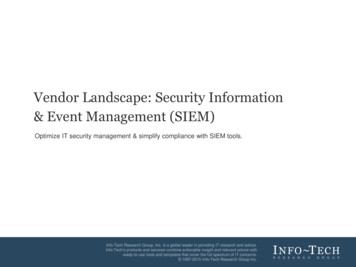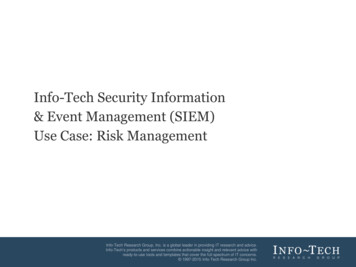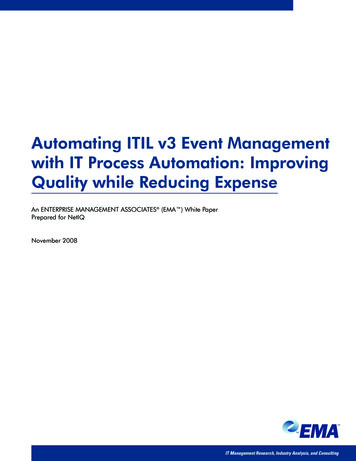
Transcription
Automating ITIL v3 Event Managementwith IT Process Automation: ImprovingQuality while Reducing ExpenseAn ENTERPRISE MANAGEMENT ASSOCIATES (EMA ) White PaperPrepared for NetIQNovember 2008IT Management Research, Industry Analysis, and Consulting
Automating ITIL v3 Event Management with IT ProcessAutomation: Improving Quality while Reducing ExpenseTable of ContentsAbstract.1Introduction.1ITIL v3 Event Management.2Positioning Event Management within Service Operations.3Incident Management.3Problem Management.3Service Desk.3Monitoring.4Event Management Challenges.4Automating Event Management.5Event Correlation.5IT Process Automation.6Improving Quality and Reducing Expenses with NetIQ Solutions.6NetIQ AppManager.6NetIQ Aegis.7Automating Response to Common Events - A Real World Scenario.7EMA Perspective.8About NetIQ.8 2008 Enterprise Management Associates, Inc. All Rights Reserved.
Automating ITIL v3 Event Management with IT ProcessAutomation: Improving Quality while Reducing ExpenseAbstractIT organizations around the world are improving their IT operations capabilities by implementing the Incident and Problem Management processes from the IT InfrastructureLibrary (ITIL). Yet while the majority of those organizations are focused on ITIL v2process adoption, the ITIL Event Management process is notintroduced until ITIL v3.Fortunately, Event Management can – and should – be usedalong with Incident and Problem management, regardless ofITIL version. The foundation it provides for improving otherITIL processes, as well as its potential for cost savings, positions Event Management as a critical process for organizationsat any stage of ITIL adoption.Event Management can– and should – be usedalong with Incident andProblem management,regardless of ITIL versionThis paper introduces ITIL v3 Event Management principles,related activities, and typical challenges. It then discusses howto resolve those challenges using best practices as well as ITProcess Automation (ITPA). Automating the process of Event Management with ITPAlowers IT costs by reducing manual labor. This approach also improves quality by ensuringrapid and consistent incident resolution.A complete Event Management solution from NetIQ , including automation, is also explored. NetIQ AppManager and NetIQ Aegis provide broad event monitoring aswell as automation through both event correlation and ITPA. A real-world scenario forautomating Event Management using these products from NetIQ is introduced.IntroductionITIL provides a framework of best practice guidance for the management of IT. However,rather than the traditional focus of IT on technology management, ITIL recognizes the ITorganization as a provider of services. An IT service, such as email or Internet access, provides the means of delivering value to users without the need to be aware of, understand,or worry about the underlying technology or management processes.P ercent of R espondents U sing Framew ork20%CMMI22%COBIT23%ISO2000040%Six Sigma62%ITIL0%10%20%30%40%50%60%70%Figure 1 - Best Practice Framework Adoption 2008 Enterprise Management Associates, Inc. All Rights Reserved.
Automating ITIL v3 Event Management with IT ProcessAutomation: Improving Quality while Reducing ExpenseNow in its third version, ITIL has become the most widely adopted best practice frameworkfor IT management throughout the world. Based on EMA research, Figure 1 illustrates therate of adoption of ITIL versus other frameworks.Each version of ITIL has improved over its predecessor and a key improvement in ITILv3 is the addition of a Service Lifecycle that includes five stages: Service Strategy, ServiceDesign, Service Transition, Service Operation, and Continual Service Improvement.It is the Service Operation book that describes the best practice processes used to managethe applications and infrastructure that support the delivery of services. It is during thisstage of the lifecycle that services actually deliver their value.The IT operations staff must ensure the value of those services is delivered to the fundingorganization and its users by managing their health from end to end. Of course, this doesnot happen without challenges. There are many tradeoffs – whether tactical, strategic oreconomic – within any IT organization. Decisions must be made carefully around reactiveversus proactive management, quality versus cost, and levels of staffing versus automation,especially during times of tightly constrained budgets.The ITIL v3 Event Managementprocess serves as a case in pointfor the challenges involvedwith IT operationsThe ITIL v3 Event Management process serves as a case inpoint for the challenges involved with IT operations. It is vitalfor ensuring the operational health of services, and there are anumber of critical decisions to make so it can be done cost-effectively and with high quality. Strangely, there was no specificEvent Management process in ITIL v2. Now, with ITIL v3, theEvent Management process is clearly articulated in the ServiceOperation book and is instrumental in delivering agreed levelsof service. Many of the other twenty-six ITIL v3 processes alsobenefit from integration with the Event Management process.ITIL v3 Event ManagementITIL v3 defines an event as a change of state that has significance for the managementof a configuration item or IT service. This definition is intentionally quite broad since it isused to describe a practically unlimited number of scenarios. Some events simply indicatenormal activity where no additional action is required. Other events may signal the need forroutine action such as archiving to a log file. Still other events may indicate the abnormaloperation of a service or configuration item and require an incident to be created. Thevarious types of events may be classified as follows: Informational – These events indicate normal operational activity. However, they arestill useful for trending, statistics and reporting. They may also be used for researchingpast activity. These events usually don’t require further action. By way of example, aninformational event may be created when a user logs on to a system. Warning – These events indicate some unusual activity, status or operation. Theymay need further review or processing to determine if additional action should betaken. For example, when a system is approaching a threshold of memory utilizationa warning event may be generated to indicate that system performance may begin todegrade soon. 2008 Enterprise Management Associates, Inc. All Rights Reserved.
Automating ITIL v3 Event Management with IT ProcessAutomation: Improving Quality while Reducing Expense Exception – These events typically indicate something bad has happened. They needimmediate review and may require action to resume normal operation or service levels.An example of an exception event is a network outage or system failure.While the Incident Management process is invoked when some events occur, it is important to note that Event Management is not the same as Incident Management. In fact, ITILv3 has positioned Event Management, Incident Management and Problem Management aspeer processes within Service Operations.Positioning Event Management within Service OperationsThe Service Operations stage of the ITIL v3 Service Lifecycle includes several relatedprocesses, functions and activities that are often confused with Event Management. Toget the most from the Event Management process it is important to understand howthese other elements of Service Operations differ from as well as support the EventManagement process.Incident ManagementThe Service Operations stage of theITIL v3 Service Lifecycle includesseveral related processes, functionsand activities that are oftenconfused with Event Management.ITIL v3 defines an incident as an unplanned interruption toan IT service, or a reduction in the quality of an IT service.Incidents also include the failure of a configuration item – evenif it has not yet impacted a service. Some events may result inthe creation of a corresponding incident. Users may also detectincidents and report them directly to the Service Desk. Whenan incident occurs, the Incident Management process is responsible for restoring normal service operation and reducing theimpact on users and business operations.Problem ManagementITIL v3 defines a problem as the cause of one or more incidents. The idea behind ProblemManagement is to prevent incidents from occurring or recurring. This implies a proactiveapproach for preventing incidents. It also implies that the root cause of incidents must befound and fixed through a Change Management process to eliminate recurring incidents.A good Problem Management process will also retain information about problems, workarounds, recovery processes and solutions to assist with the Incident Management process.Service DeskRather than a process, the Service Desk is an ITIL function. As mentioned, users mayreport incidents directly to the Service Desk. Whether incidents are derived from the EventManagement process or from individual users, the Service Desk is responsible for trackingand managing them. The Service Desk function manages the incident lifecycle includingcategorization and prioritization, initial investigation, involvement of specialists, providingstatus to users, and closing incidents when the user is satisfied. 2008 Enterprise Management Associates, Inc. All Rights Reserved.
Automating ITIL v3 Event Management with IT ProcessAutomation: Improving Quality while Reducing ExpenseMonitoringThere are a number of common Service Operation activities that are not defined as ITILprocesses. The monitoring activity is used to detect the status of services to ensure theymaintain committed service levels and ultimately deliver their expected value to the business.Monitoring tools are designed to capture events sent by configuration items. Monitoringtools may also independently check the status of services or configuration items and createevents when, for instance, status information is found to be outside normal ranges.To summarize, when a warning or exception event has been detected by the EventManagement process or Monitoring Activities, it may also result in an incident, problemor change. Or, in the case of an informational event, it may simply be logged for possiblefuture use. The Service Desk function manages the lifecycle of all incidents, whether theywere reported by individual users, the Event Management process or Monitoring Activities.Event Management in ITIL v3 is a distinct process of its own. It also relates to severalother ITL processes, functions and activities within Service Operations as well as otherstages of the Service Lifecycle.Event Management ChallengesThe tools, processes and configuration items in an IT environment should be configuredto generate the right set of events. If required events are not produced, or if monitoringtools do not detect required events, the risk for a negative service impact rises dramatically.When events with predictive value are lost, ignored or simply not generated, processes likeIncident and Problem Management will fail to take needed action.Most event consuming processessuffer from too many ratherthan too few events.However, most event consuming processes suffer from toomany rather than too few events. Consider the load on theService Desk function if every event were to create a corresponding incident. Simply recording and tracking these eventswould be overwhelming. The Service Desk staff should spendits time only on events that matter to the supported business.Yet only a portion of all events are important from a serviceimpact perspective.Determining and defining which events should be generated depends in part on the processes that will consume them. Event logging processes require a large number of events– even simple informational events – to be captured and saved for potential future use. Yetit turns out that many events are simply duplicates or provide the same information valueas other events. So capturing every single possible event is not really the objective. It is farbetter to perform some intelligent processing of events to eliminate duplicates, retain thosewith specific value, and organize them so they become most useful to the processes thatconsume them.Yet even if events can be reduced to a subset where each remaining event has specificvalue, someone or something still needs to make sense of them. These meaningful eventsneed to be categorized, prioritized and routed to the appropriate person or process so thatnecessary action – even if it is to simply log the event – can be determined and taken. Forinstance, the Service Level Management process must track the occurrence and trends ofevents related to service levels agreements (SLA). 2008 Enterprise Management Associates, Inc. All Rights Reserved.
Automating ITIL v3 Event Management with IT ProcessAutomation: Improving Quality while Reducing ExpenseLarge, complex, and/or heterogeneous environments often include cumbersome, humanintensive activities in the Event Management process. In order to scale, events need tobe assigned to the right owners who often have expert knowledge on a limited set ofapplications. However, operations teams continue to be organized around technology domains resulting in silos of data and expertise. The challenge of scaling event processingis compounded by the fact that many events that turn into incidents or problems requireinvolvement of multiple experts that are working on separate teams.A robust Event Managementprocess built on well-designedtools can dramatically reducecosts by reducing manuallabor requirementsOverall, many IT organizations have yet to gain control of theirService Operation processes. This leads to high costs as wellas low quality services. Fortunately, with the introduction ofITIL v3, more organizations are realizing that improvementsin the Event Management process have a large and positivedownstream impact on other ITIL processes. A robust EventManagement process built on well-designed tools can dramatically reduce costs by reducing manual labor requirements. It cantransform IT from reactive to proactive so that service qualityand consistency can be significantly improved.Automating Event ManagementDifferent ITSM vendors have each taken different paths toward addressing the challengesof Event Management. Some have realized that any substantial solution must incorporate automation. The classic, and still highly valuable, approach to automating the EventManagement process is event correlation. Another approach to automation, though currently less well known, takes Event Management to an entirely new level by utilizing ITProcess Automation (ITPA) to replace manual recovery actions.Event CorrelationEvent correlation directly attacks the challenges related to having too many events. It helpspinpoint the relatively few events and corresponding information that are really important.It can be described by four related steps. E vent Filtering eliminates irrelevant events. Since the event correlation process maybe distributed across a number of tools which often specialize in particular types ofevents, event relevancy may be determined in the context of individual tools. E vent Aggregation or De-duplication involves eliminating multiple copies of thesame event. Some event sources continue to generate events – with the same information– until the issue causing the events is resolved. Many events can be eliminated by simplykeeping one of the events, perhaps along with a count of the number of occurrenceswithin a relevant time period. E vent Masking makes use of the idea that some events are already implied by otherevents and can be eliminated. If a segment of an organization’s network fails, it is readilyapparent that systems, storage and application components which are only connectedthrough that segment will not be accessible. 2008 Enterprise Management Associates, Inc. All Rights Reserved.
Automating ITIL v3 Event Management with IT ProcessAutomation: Improving Quality while Reducing Expense R oot Cause Analysis is essentially a more complex and powerful version of eventmasking since it also determines which events can be explained by others. However, ituses more intelligence, like dependency maps, to eliminate extraneous events generatedby the root cause event.IT Process AutomationThe other notable approach to automation, pioneered by NetIQ, is based on integratingITPA with Event Management. When used in sequence, after event correlation, ITPA hasthe power to make IT Operations far more efficient and effective at managing the operational health of services. Focusing only on the events that matter, ITPA cuts down onmanual processing and reduces IT costs.The other notable approach toautomation, pioneered by NetIQ,is based on integrating ITPAwith Event Management.ITPA solutions have been found useful for automating a wide variety of repetitive operations tasks including those found in runbooks. Network and systems operations staff as well as systemsadministrators follow procedures in run books for everythingfrom re-starting a server to provisioning a new service. Theseprocedures cover all steps required to complete various activities, and, for more complex processes, include decision trees sothat variations in environmental variables can be addressed.As noted in ITIL v3, responses to events may be driven manually or through automation. ITPA is perfectly matched to many of the automation opportunities around EventManagement. However, with such a focus on provisioning applications of ITPA like ChangeManagement, most vendors have yet to apply ITPA to Event Management.Improving Quality and Reducing Expenses withNetIQ SolutionsThrough two solutions, NetIQ provides a comprehensive approach to automated EventManagement. NetIQ AppManager provides monitoring across a wide range of technologies while NetIQ Aegis goes beyond ev
benefit from integration with the Event Management process. ITIL v3 Event Management ITIL v3 defines an event as a change of state that has significance for the management of a configuration item or IT service.
